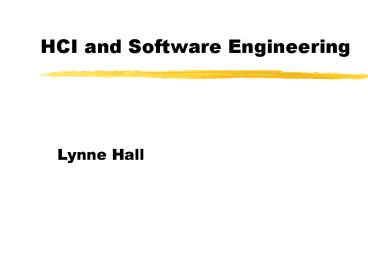HCI and Software Engineering - PowerPoint PPT Presentation
1 / 18
Title:
HCI and Software Engineering
Description:
Some methodologies (SSADM 4.0) have ... Eclectic, flexible methodology. HCI input at many stages ... Many HCI methods incorporated (often with 'new' names) ... – PowerPoint PPT presentation
Number of Views:106
Avg rating:3.0/5.0
Title: HCI and Software Engineering
1
HCI and Software Engineering
- Lynne Hall
2
History (still ongoing)HCI and Structured
Methods
- HCI input mainly in
- Requirements analysis stage
- Testing
- Rollout
- Some methodologies (SSADM 4.0) have specific HCI
steps in various stages - Possible to incorporate HCI but often as add-ins
to the methodology
3
The FutureHCI and Object Orientation
- Eclectic, flexible methodology
- HCI input at many stages
- Cyclical incremental software development
approach - Many HCI methods incorporated (often with new
names) - Added-value / Assimilation not add-in / extra
- Object - Action Interface Model
4
HCI and Object Orientation
Where does HCI fit in? Everywhere...
5
Inception
- HCI focus often present
- Inception of modifications
- response to user testing
- proactive response to user queries / suggestions
- Inception of new applications
- From HCI literature / research / competition
- A way to electronically support a work function
6
Aims are context dependent
- safety-critical systems
- industrial and commercial systems
- office systems
- home and entertainment systems
- exploratory and creative systems
- Context is dependent on who, why, when, and where
7
Contextual Profile
- Who are your intended users?
- Department of an organisation
- General population
- 7-9 year olds
- Why are they using the application?
- Part of their job
- Recreational activity
- Educational
8
Contextual Profile 2
- Where are they using the application
- work-based
- home-based
- web-based
- When does the user use the application
- Part of a specific weekly performed task
- Whenever they want
- In set time periods
9
Elaboration
- Key area for HCI
- HCI of prime importance to determine use cases
- Requirements Engineering
- Competitive Analysis
- Environment Analysis
- User Profiles
- Task Descriptions
10
Requirements, Constraints, Opportunities and
Trade-Offs
- When to find out
- Who to ask / Informative Sources
- users
- stakeholders
- electronic / paper information sources
- competitive analysis
- Other members of the team
- Other HCI people
11
Requirements Engineering
- User Characteristics
- Task Characteristics
- Environment Characteristics
- Stakeholder Needs
- Documentation Reviews, Interviews, Low Fidelity
Prototyping, Observing, etc.
12
Construction
- Series of iterations
- Each iteration is based on a use case and
involves - analysis
- design
- coding
- testing
- integration
13
Analysis
- Usability Attributes of Use Cases
- Different user interfaces
- screen
- on-line help
- manual
- Low Fidelity Prototyping, Interviews, Task
Analysis, Competitive Analysis
14
Design
- Objects describe the universe
- Actions the intentions of the actor
- Interaction style
- Dialogue Design / Screen layout
- Design of secondary user interfaces
- guidelines, standards, low fidelity techniques,
user review, usability testing
15
Coding
- High Fidelity Prototyping
- Programming
- Development of interface objects (graphical)
- High Fidelity Prototyping tools, programming
languages, graphical development environments,
scanned-in artwork etc.
16
Testing
- Testing is vital.
- No interface design / code should be built unless
you know how to test it - Until the testing is complete, the software is
still prototypical - usability test plan, heuristic evaluation,
guidelines, usability metrics
17
Integration
- Integrating stand-alone functions into a complete
application - Importance of consistency (especially relevant in
big projects) - User Testing, Evaluation, Horizontal Prototyping,
Consistency checking
18
Transition
- No development to add functionality
- Optimising the application
- Providing secondary user interfaces
- User evaluation, efficiency, accuracy, speed,
user manuals, training, usability problem
notification procedures































